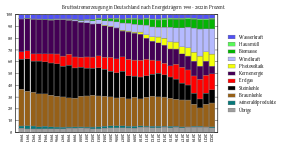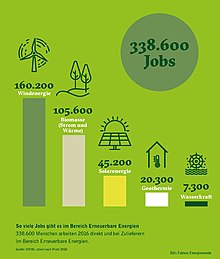- Biogas fermenter in Hornstet
- Wind park in Bernburg
- Geothermal power plant in Neustadt-Glewe
- German wind and solar in Rhineland-Palatinate


Renewable energy in Germany is mainly based on wind and biomass, plus solar and hydro. Germany had the world's largest photovoltaic installed capacity until 2014, and as of 2023 it has over 82 GW. It is also the world's third country by installed total wind power capacity, 64 GW in 2021[1] (59 GW in 2018[2]) and second for offshore wind, with over 7 GW. Germany has been called "the world's first major renewable energy economy".[3][4]
The share of renewable energy in electricity production has increased from 3.5% in 1990 to 52.4% in 2023.[5][6] As with most countries, the transition to renewable energy in the transport and heating and cooling sectors has been considerably slower.[7][8]
According to official figures, around 370,000 people were employed in the renewable energy sector in 2010, particularly in small and medium-sized companies.[9] This is over twice the number of jobs in 2004 (160,500). About two-thirds of these jobs are attributed to the Renewable Energy Sources Act.[10][11]
Germany's federal government is working to increase renewable energy commercialization,[12] with a particular focus on offshore wind farms.[13] A major challenge is the development of sufficient network capacities for transmitting the power generated in the North Sea to the large industrial consumers in southern parts of the country.[14] Germany's energy transition, the Energiewende, designates a significant change in energy policy from 2011. The term encompasses a reorientation of policy from supply to demand and a shift from centralized to distributed generation (for example, producing heat and power in very small cogeneration units), which should replace overproduction and avoidable energy consumption with energy-saving measures and increased efficiency.
- ^ "Energy-Charts".
- ^ https://windeurope.org/wp-content/uploads/files/about-wind/statistics/WindEurope-Annual-Statistics-2018.pdf [bare URL PDF]
- ^ "Germany: The World's First Major Renewable Energy Economy". Archived from the original on 29 March 2015. Retrieved 15 April 2009.
- ^ Fraunhofer ISE, Electricity production from solar and wind in Germany – New record in wind power production, p.2 15 December 2014
- ^ Cite error: The named reference
BMW-erneuerbare-energienwas invoked but never defined (see the help page). - ^ "Share of electricity production from renewables: Germany". Our World in Data. 20 June 2024. Retrieved 6 October 2024.
- ^ "Where leading countries stand in the transition to renewable heating, road transport and electricity". Bertelsmann Stiftung. 1 October 2024. Retrieved 6 October 2024.
- ^ "Renewable energy statistics". Eurostat. December 2023. Retrieved 6 October 2024.
- ^ Gerhardt, Christina (9 June 2016). "Germany's Renewable Energy Shift: Addressing Climate Change". Capitalism, Nature, Socialism. 28 (2): 103–119. doi:10.1080/10455752.2016.1229803. S2CID 157399085.
- ^ Renewable Energy Sources in Figures – National and International Development Archived 2 March 2012 at the Wayback Machine
- ^ "Germany Leads Way on Renewables, Sets 45% Target by 2030". Archived from the original on 2 January 2020. Retrieved 2 November 2007.
- ^ "100% renewable electricity supply by 2050". Federal Ministry for Environment, Nature Conservation and Nuclear Safety. 26 January 2011. Archived from the original on 9 May 2011. Retrieved 4 June 2011.
- ^ Schultz, Stefan (23 March 2011). "Will Nuke Phase-Out Make Offshore Farms Attractive?". Der Spiegel. Retrieved 26 March 2011.
- ^ The Wall Street Journal Online, 24 April 2012



